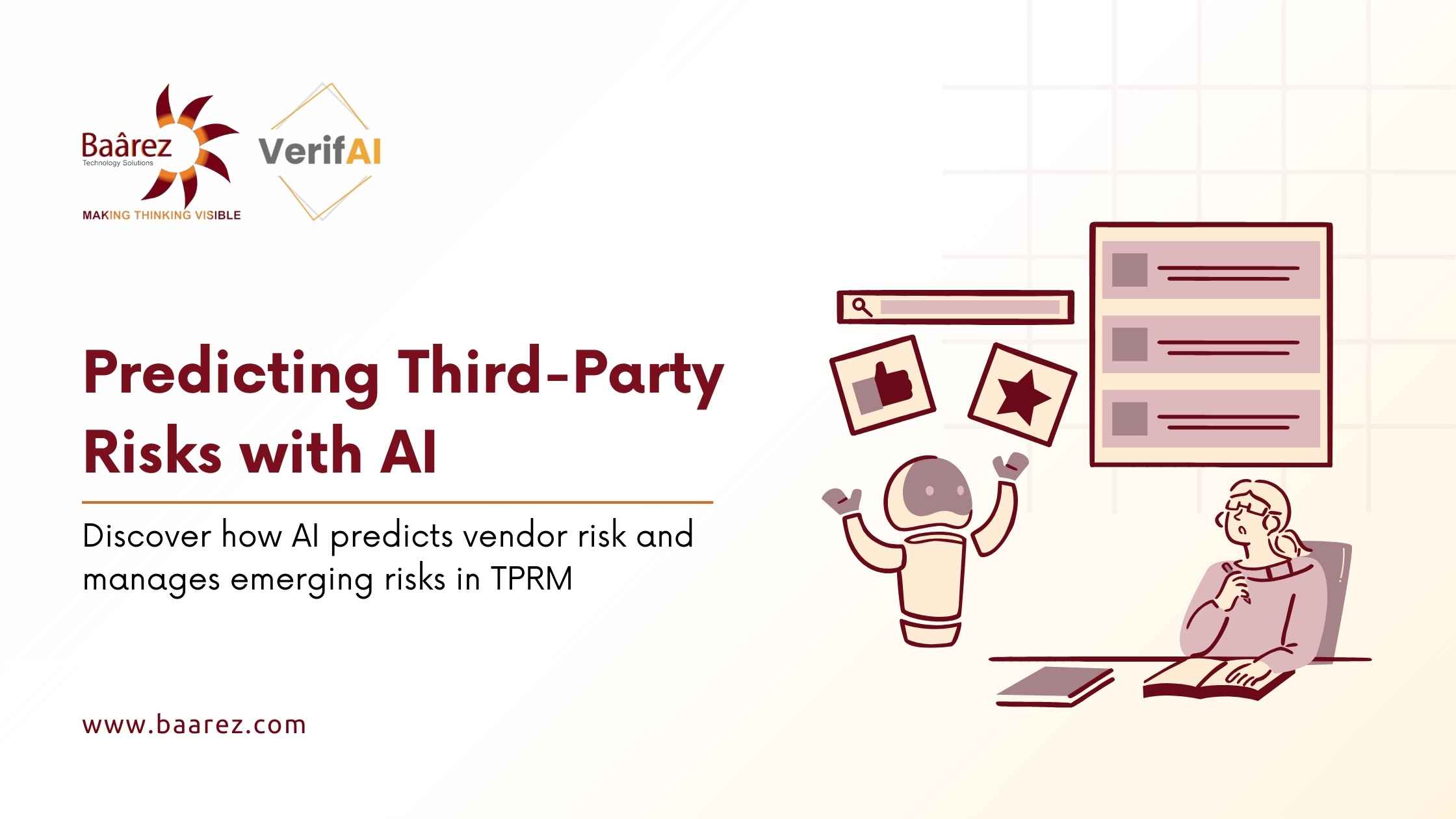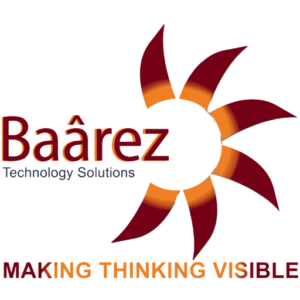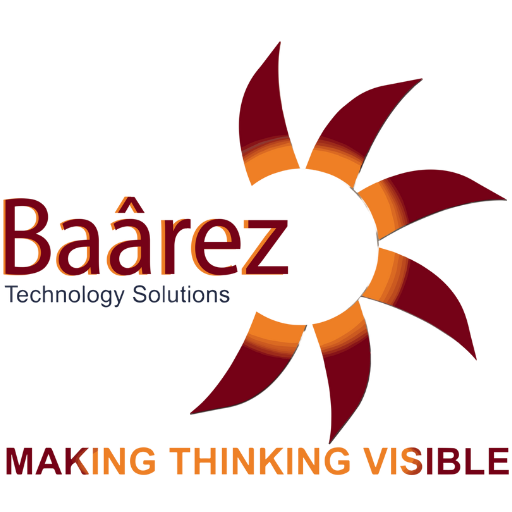
Managing vendors has always been a challenge, but in today’s digital supply chains, risks are no longer just financial or operational—they are dynamic and constantly evolving. Cybersecurity breaches, sudden regulatory changes, ESG (Environmental, Social, Governance) obligations, and geopolitical issues are reshaping how businesses approach third-party risk management (TPRM).
Traditional methods often fail to catch these fast-moving threats in time. That’s where AI predicting vendor risk and predictive TPRM come in. Artificial Intelligence allows organizations to move from reactive monitoring to proactive and predictive insights, giving businesses an early warning system for emerging risks in TPRM.
Table of Contents
ToggleWhat Are Emerging Third-Party Risks?
When businesses work with vendors, suppliers, and partners, they inherit risks that may not be immediately visible. These are known as third-party risks. While traditional risks like delayed deliveries or financial instability are well understood, companies now face a new category: emerging third-party risks.
Emerging risks are threats that evolve quickly and are difficult to predict with manual monitoring methods. They often arise from global trends, regulatory shifts, or sudden changes in the external environment.
Examples of Emerging Risks in TPRM
- Cybersecurity Threats: Ransomware, phishing, and data breaches targeting vendors.
- Regulatory Changes: New data protection, financial, or tax compliance laws.
- Geopolitical Disruptions: Trade wars, sanctions, or regional instability.
- Supply Chain Breakdowns: Natural disasters, pandemics, or resource shortages.
- ESG-Related Risks: Vendors failing to meet sustainability or ethical standards.
In short, emerging risks in TPRM are more dynamic and unpredictable compared to traditional risks. This makes it harder for businesses to stay ahead using manual or outdated monitoring methods. That’s why AI predicting vendor risk is becoming a critical necessity.
Why Is Predicting Vendor Risk So Important?
Every organization depends on vendors for critical operations—whether it’s IT services, raw materials, or cloud infrastructure. But when a vendor faces a disruption, it doesn’t just affect them—it directly impacts your business. That’s why predicting vendor risk before it becomes a problem is essential.
The High Cost of Ignoring Vendor Risks
- Financial Losses: A single vendor data breach can cost millions in fines, legal fees, and remediation.
- Operational Downtime: Vendor failure can halt supply chains, delay projects, or disrupt customer services.
- Reputational Damage: Customers lose trust if your vendor mishandles data or violates compliance.
- Regulatory Penalties: Non-compliance with standards like GDPR, HIPAA, or ISO can lead to strict penalties.
Why AI Makes a Difference
- Traditional risk assessments happen once a year or quarterly.
- AI predicting vendor risk works continuously, scanning thousands of data sources in real-time.
- Instead of reacting after a breach or disruption, companies can act before the risk materializes.
In simple terms: Predicting vendor risk is not just about avoiding losses—it’s about building resilience and staying competitive.
How AI Is Transforming Third-Party Risk Management
Traditional third-party risk management (TPRM) has long relied on questionnaires, manual audits, and periodic assessments. While useful, these methods are static—they capture a snapshot of vendor risk at a single point in time. Unfortunately, risks don’t wait for annual reviews. They evolve daily.
This is where AI predicting vendor risk brings a fundamental shift. By leveraging predictive TPRM, businesses can move from reactive monitoring to proactive and preventive strategies.
How AI Adds Value to TPRM
- Early Warning Signals: AI detects unusual vendor behavior, financial red flags, or compliance issues before they escalate.
- Holistic Risk View: It consolidates structured (financial data, audits) and unstructured data (news, social media) for complete visibility.
- Faster Response Time: Risk alerts are sent in real time, allowing businesses to act immediately.
- Smarter Decision-Making: Predictive insights guide vendor selection, contract negotiations, and ongoing risk strategy.
In short, AI is transforming third-party risk management by providing organizations with continuous, predictive insights instead of reactive snapshots. This proactive approach helps businesses build stronger, more resilient vendor ecosystems.
Key AI Technologies Powering Predictive TPRM
Artificial Intelligence is not a single technology—it’s a combination of advanced tools that work together to predict, analyze, and prevent vendor risks. In predictive TPRM, several AI technologies are making a major impact.
Machine Learning (ML) for Vendor Risk Scoring
Machine Learning algorithms analyze historical data from vendors—such as financial performance, delivery records, and compliance history—to identify hidden patterns.
- ML assigns a dynamic risk score to each vendor.
- It adjusts in real-time as new data becomes available.
- Example: If a supplier starts missing deadlines more frequently, their risk score increases automatically.
Natural Language Processing (NLP) for Emerging Risk Detection
NLP helps businesses make sense of vast unstructured data, including:
- News articles about vendor lawsuits.
- Social media chatter about supply chain disruptions.
- Regulatory updates mentioning new compliance rules.
By scanning these sources, NLP can flag emerging risks in TPRM that might otherwise be overlooked.
Predictive Analytics for Scenario Forecasting
Predictive analytics uses data models to forecast “what-if” scenarios.
- What if a vendor’s region experiences political unrest?
- What if raw material prices suddenly rise?
- What if regulatory fines increase?
This technology allows companies to prepare in advance, reducing financial and operational shocks.
AI-Powered Risk Dashboards & Real-Time Alerts
Modern TPRM platforms powered by AI don’t just generate reports—they provide:
- Visual dashboards with risk trends, vendor scores, and performance metrics.
- Real-time alerts when unusual activity or potential risks are detected.
- Customizable insights so risk managers focus on the vendors that matter most.
These technologies together create a comprehensive predictive TPRM framework—turning AI into a powerful shield against both current and future vendor risks.
Benefits of AI in Predicting Vendor Risk and Emerging Risks
Using AI in third-party risk management (TPRM) does more than automate tasks—it changes the way organizations think about risk. Instead of reacting to problems after they occur, AI allows businesses to predict and prepare for them. This shift from reactive to predictive TPRM creates measurable benefits.
Key Benefits
- Proactive Risk Management
- AI predicting vendor risk means companies can act before disruptions happen.
- Early detection helps avoid costly surprises like breaches or compliance fines.
- Continuous Monitoring
- Unlike periodic reviews, AI provides 24/7 oversight of vendor performance.
- This ensures no blind spots between audit cycles.
- Faster Decision-Making
- Real-time dashboards and alerts reduce the time spent on manual analysis.
- Risk managers can respond immediately to emerging threats.
- Improved Vendor Selection
- AI-powered risk scores guide smarter onboarding decisions.
- Companies can choose partners with lower long-term risk exposure.
- Cost Savings
- Preventing risks is always cheaper than fixing problems after they occur.
- Organizations reduce penalties, downtime, and reputational damage.
With AI, companies move from reacting to vendor problems to preventing them altogether. This not only strengthens resilience but also builds trust with regulators, customers, and stakeholders.
Challenges of Using AI in Predictive TPRM
While AI predicting vendor risk offers clear benefits, implementing it in a TPRM program is not without challenges. Many organizations struggle with data quality, integration, and over-reliance on algorithms. To maximize results, it’s important to understand these barriers.
Common Challenges
- Data Quality Issues
- AI depends on high-quality data.
- Incomplete, outdated, or biased vendor information can lead to inaccurate predictions.
- Integration with Existing Systems
- Many organizations still rely on legacy risk management tools.
- Integrating AI with these systems requires investment and careful planning.
- Over-Reliance on Algorithms
- AI is powerful but not infallible.
- Human expertise is still necessary to validate predictions and make strategic decisions.
- Regulatory and Ethical Concerns
- Vendors may operate across different jurisdictions with unique compliance laws.
- Over-collection or misuse of data can lead to privacy and legal issues.
- High Initial Investment
- Deploying AI-powered predictive TPRM tools requires upfront costs.
- Small and mid-sized businesses may find it challenging without a phased approach.
While challenges exist, they are not roadblocks. With the right strategy, predictive TPRM powered by AI can be implemented effectively, balancing automation with human judgment.
Best Practices for Implementing AI in TPRM Programs
Adopting AI predicting vendor risk tools is not just about technology—it requires a clear strategy. Businesses that succeed with predictive TPRM follow best practices that balance automation, governance, and human expertise.
Best Practices to Follow
- Build a Strong Data Foundation
- Ensure vendor data is accurate, up-to-date, and comprehensive.
- Invest in data governance frameworks to maintain quality.
- Start Small with Pilot Programs
- Begin with a few high-risk vendors to test AI capabilities.
- Scale gradually once the system proves effective.
- Combine AI Insights with Human Expertise
- AI provides predictions, but risk managers should validate and interpret results.
- Human oversight prevents over-reliance on algorithms.
- Integrate AI with Existing Risk Systems
- Use APIs and modular tools for seamless integration with existing TPRM frameworks.
- Avoid silos by connecting AI platforms with procurement, compliance, and finance systems.
- Stay Aligned with Compliance Regulations
- Ensure that AI-driven risk assessments meet global standards (GDPR, HIPAA, ISO).
- Document AI decision-making for audit purposes.
- Continuously Retrain AI Models
- Emerging risks evolve rapidly, so AI models must be updated regularly.
- Continuous learning improves accuracy over time.
The most successful organizations treat predictive TPRM as a partnership between AI and humans. Technology handles scale and speed, while human experts provide context and judgment.
How Baarez Technology Solutions Can Help With AI Predicting Vendor Risk
At Baarez Technology Solutions, we understand that emerging risks in TPRM can put your entire business ecosystem at stake. That’s why we provide VerifAI an advanced AI-powered third-party risk management solutions designed to predict, monitor, and mitigate vendor risks before they escalate.
Key Features of Baarez AI-Powered Predictive TPRM
- Continuous Monitoring: 24/7 scanning of vendor activity across financial, operational, and cybersecurity domains.
- Predictive Analytics: AI models that forecast potential vendor disruptions using real-time and historical data.
- Dynamic Risk Scoring: Machine learning that adjusts vendor scores as new data emerges.
- Regulatory Compliance Alerts: Automatic updates on compliance changes across multiple jurisdictions.
- Customizable Dashboards: Easy-to-understand visual insights for leadership teams.
Why Choose Baarez Technology Solutions?
- Proactive Risk Mitigation – Identify risks before they harm your business.
- Tailored Solutions – AI-driven frameworks customized for your industry and regulatory environment.
- Scalable Approach – Works for businesses of all sizes, from startups to large enterprises.
- Expert Support – Our consultants blend AI insights with decades of TPRM expertise.
Future-proof your vendor ecosystem with Baarez VerifAI AI-powered predictive TPRM solutions. Don’t wait for risks to disrupt your operations—predict them before they happen.
Schedule a demo today to see how our AI platform can transform your third-party risk management program.


